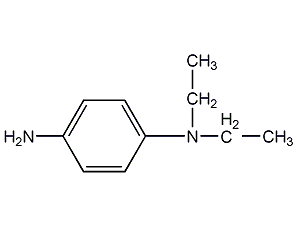N,N-diethyl-p-phenylenediamine

Structural formula
| Business number | 025P |
|---|---|
| Molecular formula | C10H16N2 |
| Molecular weight | 164.25 |
| label |
4-diethylaminoaniline, p-Amino-N,N-diethylaniline, Diethyl p-phenylenediamine, N,N-diethyl-1,4-phenylenediamine, p-Amino-N,N-diethylaniline, Diethyl-N,N-p-phenylenediamine, 4-(Diethylamino)aniline, 4-Diethylaminoaniline, N,N-diethyl-p-phenylendiamine, DPD, 4-(Diethylamino)aniline, p-Amino-N,N-diethylaniline, N,N-Diethyl-1,4-phenylenediamine, developer |
Numbering system
CAS number:93-05-0
MDL number:MFCD00007861
EINECS number:202-214-1
RTECS number:SS9275000
BRN number:879361
PubChem number:24855816
Physical property data
1. Properties: Light yellow liquid, changes color when exposed to light or air.
2. Density (g/mL, 25/4℃): 0.988
3. Relative vapor density (g/mL, air=1): Undetermined
4. Melting point (ºC): 23
5. Boiling point (ºC, normal pressure): 260-262
6. Boiling point (ºC, 5.2kPa): Undetermined
7. Refractive index: 1.571
8. Flash point (ºC): 139
9. Specific rotation (º): Undetermined
10. Autoignition point or ignition temperature (ºC): Undetermined
11. Vapor pressure (kPa, 25ºC): Undetermined
12. Saturated vapor pressure ( kPa, 60ºC): Undetermined
13. Heat of combustion (KJ/mol): Undetermined
14. Critical temperature (ºC): Undetermined
15. Critical pressure (KPa): Undetermined
16. Log value of oil-water (octanol/water) partition coefficient: Undetermined
17. Explosion upper limit (%, V/ V): Undetermined
18. Lower explosion limit (%, V/V): Undetermined
19. Solubility: Can be mixed with alcohol and ether, insoluble in water.
Toxicological data
None
Ecological data
None
Molecular structure data
1. Molar refractive index: 54.06
2. Molar volume (cm3/mol): 162.7
3. Isotonic specific volume (90.2K ): 414.7
4. Surface tension (dyne/cm): 42.1
5. Polarizability (10-24cm3): 21.43
Compute chemical data
1. Reference value for hydrophobic parameter calculation (XlogP): None
2. Number of hydrogen bond donors: 1
3. Number of hydrogen bond acceptors: 2
4. Number of rotatable chemical bonds: 3
5. Number of tautomers: none
6. Topological molecule polar surface area 29.3
7. Number of heavy atoms: 12
8. Surface charge: 0
9. Complexity: 113
10. Number of isotope atoms: 0
11. Determine the number of atomic stereocenters: 0
12. Uncertain number of atomic stereocenters: 0
13. Determine the number of chemical bond stereocenters: 0
14. Number of uncertain chemical bond stereocenters: 0
15. Number of covalent bond units: 1
Properties and stability
This product is toxic and may cause obvious allergic reactions on skin contact.
Storage method
1. This product is toxic. Toxic chemicals such as diethylaniline and sodium nitrite are used in the production process. Therefore, the equipment must be sealed and production personnel must wear protective gear when operating. Reactive materials should be prevented from direct contact with skin or inhalation of dust.
2. Packed in an iron drum lined with plastic bags and stored in a cool, dry place away from light. Store and transport according to regulations on toxic chemicals.
Synthesis method
Using N,N-diethylaniline as raw material, it is obtained through nitrosation, reduction and neutralization: the process is as follows: (1) Nitrosation: Add 150kg water, 35kg N,N-diethylaniline and 72kg to the kettle Hydrochloric acid, cool to 0°C. At 0-5°C, add 50% sodium nitrite solution (prepared to 100% 18.5kg). After adding, stir for half an hour and add 6kg of salt. Stir for 2h. Filter to obtain p-nitroso-N,N-diethylaniline. (2) Reduction and neutralization Add 150kg water and 11kg hydrochloric acid to the kettle. Stir, add 41kg of iron powder, cool to 15°C, and add nitrite at 20-25°C. After the addition is completed, add 5kg of iron powder and stir at 20-25°C for 3 hours. Add 7kg of sodium carbonate, stir for 15 minutes, and filter. The filter cake is washed with hot water. Add 50kg liquid alkali (30%) and 15kg salt to the filtrate and washing liquid, and let stand for layering. The upper material distillation kettle is distilled under reduced pressure at 120-150°C and a vacuum of 8kPa to collect the fractions to obtain p-amino-N,N-diethylaniline.
Purpose
Dye intermediates. Its hydrochloride and sulfate can be used as color photographic developers.
extended-reading:https://www.bdmaee.net/wp-content/uploads/2022/08/Neodecanoic-acid-zinc-CAS27253-29-8-Zinc-neodecanoate.pdf
extended-reading:https://www.newtopchem.com/archives/805
extended-reading:https://www.newtopchem.com/archives/39778
extended-reading:https://www.bdmaee.net/tegoamin-bde/
extended-reading:https://www.bdmaee.net/reactive-composite-catalyst/
extended-reading:https://www.cyclohexylamine.net/dabco-eg-pc-cat-td-33eg-niax-a-533/
extended-reading:https://www.newtopchem.com/archives/category/products/page/4
extended-reading:https://www.newtopchem.com/archives/1137
extended-reading:https://www.bdmaee.net/polyurethane-rigid-foam-catalyst-cas15875-13-5-jeffcat-tr-90/
extended-reading:https://www.bdmaee.net/wp-content/uploads/2022/08/102-2.jpg
